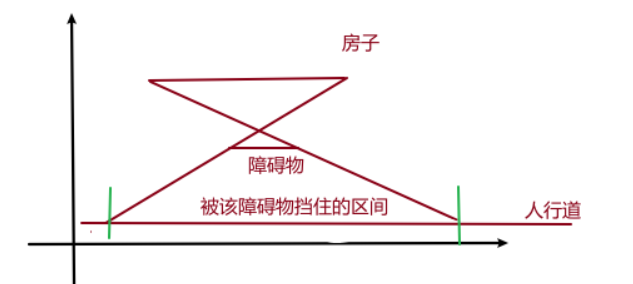大意:
给出一个房子的两个端点坐标,以及观察线的左右端点坐标,n个障碍物,问观察线上能看到完整的房子的最长连续区间。
思路:
图源:https://blog.csdn.net/weixin_43311695/article/details/109193862
算出每个障碍物导致的视野盲区,然后计算不在盲区的最长区间即可。这里处理最长区间的方法是:将所有的盲区按照左端点排序,然后更新右边区间和答案即可。还需要注意的是,如果障碍物不在房子和观察线之间,那么不需要考虑。
注意一个小trick:下标从1开始记录盲区,因为这样可以避免讨论没有盲区的情况
#include <math.h>
#include <stdio.h>
#include <string.h>
#include <algorithm>
#include <cstdio>
#include <iostream>
#include <map>
#include <queue>
#include <set>
#include <vector>
using namespace std;
const int N = 1e6 + 5;
typedef long long LL;
double dis[100][100];
// 计算几何模板
const double eps = 1e-8;
const double inf = 1e20;
const double pi = acos(-1.0);
const int maxp = 1010;
// 和0做比较
int sgn(double x) {
if (fabs(x) < eps) return 0; // =0
if (x < 0)
return -1; // < 0
else
return 1; // > 0
}
// 计算x的平方
inline double sqr(double x) { return x * x; }
struct Point {
double x, y;
int index;
Point() {}
Point(double _x, double _y) {
x = _x;
y = _y;
}
void input() { scanf("%lf%lf", &x, &y); }
void output() { printf("%.2f %.2f
", x, y); }
bool operator==(Point b) const {
return sgn(x - b.x) == 0 && sgn(y - b.y) == 0;
}
bool operator<(Point b) const {
return sgn(x - b.x) == 0 ? sgn(y - b.y) < 0 : x < b.x;
}
Point operator-(const Point &b) const { return Point(x - b.x, y - b.y); }
Point operator+(const Point &b) const { return Point(x + b.x, y + b.y); }
//叉积
double operator^(const Point &b) const { return x * b.y - y * b.x; }
//点积
double operator*(const Point &b) const { return x * b.x + y * b.y; }
//返回两点的距离
double dist(Point p) {
return sqrt((x - p.x) * (x - p.x) + (y - p.y) * (y - p.y));
}
// 极角排序
};
struct Line {
Point s, e;
Line() {}
// 两点确定一条线段
Line(Point _s, Point _e) {
s = _s;
e = _e;
}
//返回点和直线(方向向量)关系
// 1 在左侧; 2 在右侧; 3 在直线上
int relation(Point p) {
int c = sgn((p - s) ^ (e - s));
if (c < 0)
return 1;
else if (c > 0)
return 2;
else
return 3;
}
//两线段相交判断:规范相交:交点不在端点
// 2 规范相交;1 非规范相交;0 不相交
int segcrossseg(Line v) {
int d1 = sgn((e - s) ^ (v.s - s));
int d2 = sgn((e - s) ^ (v.e - s));
int d3 = sgn((v.e - v.s) ^ (s - v.s));
int d4 = sgn((v.e - v.s) ^ (e - v.s));
if ((d1 ^ d2) == -2 && (d3 ^ d4) == -2) return 2;
return (d1 == 0 && sgn((v.s - s) * (v.s - e)) <= 0) ||
(d2 == 0 && sgn((v.e - s) * (v.e - e)) <= 0) ||
(d3 == 0 && sgn((s - v.s) * (s - v.e)) <= 0) ||
(d4 == 0 && sgn((e - v.s) * (e - v.e)) <= 0);
}
bool parallel(Line v) { return sgn((e - s) ^ (v.e - v.s)) == 0; }
//求两直线的交点
//要保证两直线不平行或重合
Point crosspoint(Line v) {
double a1 = (v.e - v.s) ^ (s - v.s);
double a2 = (v.e - v.s) ^ (e - v.s);
return Point((s.x * a2 - e.x * a1) / (a2 - a1),
(s.y * a2 - e.y * a1) / (a2 - a1));
}
double length() { return s.dist(e); }
//点到直线的距离
double dispointtoline(Point p) {
return fabs((p - s) ^ (e - s)) / length();
}
//点到线段的距离
double dispointtoseg(Point p) {
if (sgn((p - s) * (e - s)) < 0 || sgn((p - e) * (s - e)) < 0)
return min(p.dist(s), p.dist(e));
return dispointtoline(p);
}
//直线和线段相交判断
//-*this line -v seg
// 2 规范相交
// 1 非规范相交
// 0 不相交
int linecrossseg(Line v) {
int d1 = sgn((e - s) ^ (v.s - s));
int d2 = sgn((e - s) ^ (v.e - s));
if ((d1 ^ d2) == -2) return 2;
return (d1 == 0 || d2 == 0);
}
};
struct Seq {
double left, right;
Seq() {}
Seq(double _left, double _right) {
left = _left;
right = _right;
}
};
Seq seq[N];
bool cmp(Seq a, Seq b) { return a.left < b.left; }
double x1, x2, y, px1, px2, py;
Line property, ob[N];
int n, cnt;
int main() {
while (scanf("%lf%lf%lf", &x1, &x2, &y) != EOF && (x1 + x2 + y != 0)) {
scanf("%lf%lf%lf", &px1, &px2, &py);
property = Line(Point(px1, py), Point(px2, py));
scanf("%d", &n);
cnt = 0;
seq[0] = Seq(0.0, 0.0);
for (int i = 1; i <= n; i++) {
double ox1, ox2, oy;
scanf("%lf%lf%lf", &ox1, &ox2, &oy);
if (oy >= y || oy <= py) continue;
Line now = Line(Point(x2, y), Point(ox1, oy));
Point lx = now.crosspoint(property);
if (lx.x >= px2) continue;
if (lx.x < px1) lx.x = px1;
now = Line(Point(x1, y), Point(ox2, oy));
Point rx = now.crosspoint(property);
if (rx.x <= px1) continue;
if (rx.x > px2) rx.x = px2;
seq[++cnt] = Seq(lx.x, rx.x);
}
sort(seq + 1, seq + cnt + 1, cmp);
double res = 0, r = px1;
for (int i = 1; i <= cnt; i++) {
res = max(res, seq[i].left - r);
r = max(r, seq[i].right);
}
res = max(res, px2 - r);
if (sgn(res) == 0)
printf("No View
");
else
printf("%.2f
", res);
}
}
